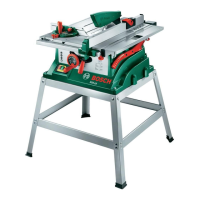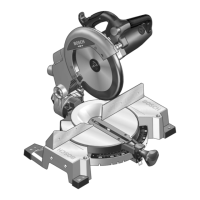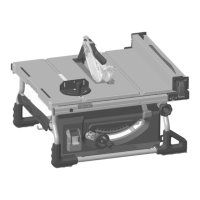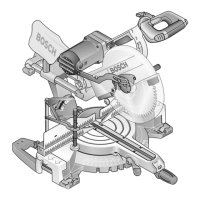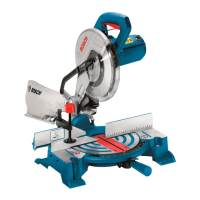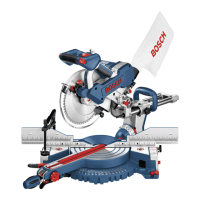English–101 609 929 J73 • (06.03) PS
5 OPERATING INSTRUCTIONS
Transport and Working Positions
Before all work on the machine, pull the mains
plug.
Transport Position
Turn the hand wheel 12 in the clockwise direction until
the teeth of the saw blade 35 are below the saw table
11.
Working Position
Turn the hand wheel 12 in the counter clockwise direc$
tion until the teeth of the saw blade 35 protrude ap$
prox. 5 mm above the work piece.
Ensure that the protective hood is properly posi>
tioned. When sawing, it must always rest on the work
piece.
Changing the Tool
Before all work on the machine, pull the mains
plug.
Wear gloves when mounting the saw blade. Danger of
injury exists for contact with the saw blade.
Select a saw blade suitable for the material to be
worked.
Use only saw blades whose allowable rotational speed
is as least as high as the no$load speed of the power
tool.
Use only saw blades that comply with the characteris$
tic data given in these operating instructions and have
been tested according to EN 847$1 and appropriately
marked.
Pay attention when changing the saw blade that the
cut width is not smaller than 2.6 mm and the basic
blade thickness is not larger than 1.8 mm. Otherwise,
the danger exists that the riving knife (2.5 mm) will jam
in the work piece.
Removing the Saw Blade
Turn the hand wheel 12 counter clockwise to the stop
so that the saw blade 35 is in the highest possible po$
sition above the saw table.
With the enclosed ring spanner 17, lift the insert plate
3 at the front (see Figure ) and remove it from the
cut$out 42.
Turn the hex$nut 56 with the ring spanner 17 (23 mm)
provided and pull the spindle lock 54 at the same time
until it engages. (see Figure )
Hold the spindle lock pulled and unscrew the hex$nut
56 in the counter clockwise direction.
Take off the clamping flange 55. Remove the saw
blade 35. (see Figure )
Mounting the Saw Blade
If necessary, clean all parts to be mounted.
Place the new saw blade on the tool spindle 57.
(see Figure )
Do not use a saw blade that is too small. The gap
between the saw blade and the riving knife can be a
maximum of 5 mm.
When mounting, observe that the cutting
direction of the saw teeth (arrow on the
saw blade) agrees with the direction of the
arrow on the protective hood!
Place on the clamping flange 55 and the nut 56. Pull
the spindle lock 54 until it engages and tighten the nut
56 in the clockwise direction.
Reinsert the table insert plate 3.
Dust/Chip Extraction
(see Figure )
Take protective measures when dust is pro>
duced while working that can be detrimental to
health, combustible or explosive. For example,
some dusts are considered carcinogenic. Wear a dust
protection mask and use dust/chip extraction, if it can
be connected.
External Dust Extraction
For extraction, a vacuum cleaner hose (35 mm dia.)
can be connected to the sawdust ejector 30.
To increase the vacuuming performance, an additional
dust extractor can be connected to the vacuuming
connection piece 5.
The vacuum cleaner must be suitable for the material
to be worked.
When vacuuming dry dust that is especially detrimen$
tal to health or carcinogenic, use a special vacuum
cleaner.
A1
A2
A3
A3
B
PTS10_WEU.book Seite 10 Donnerstag, 23. März 2006 11:47 11
